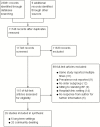The Prevalence of Orthostatic Hypotension: A Systematic Review and Meta-Analysis
- PMID: 30169579
- PMCID: PMC6909901
- DOI: 10.1093/gerona/gly188
The Prevalence of Orthostatic Hypotension: A Systematic Review and Meta-Analysis
Abstract
Background: Orthostatic hypotension (OH) is associated with increased risk of falls, cognitive impairment and death, as well as a reduced quality of life. Although it is presumed to be common in older people, estimates of its prevalence vary widely. This study aims to address this by pooling the results of epidemiological studies.
Methods: MEDLINE, EMBASE, PubMed, Web of Science, and ProQuest were searched. Studies were included if participants were more than 60 years, were set within the community or within long-term care and diagnosis was based on a postural drop in systolic blood pressure (BP) ≥20 mmHg or diastolic BP ≥10 mmHg. Data were extracted independently by two reviewers. Random and quality effects models were used for pooled analysis.
Results: Of 23,090 identified records, 20 studies were included for community-dwelling older people (n = 24,967) and six were included for older people in long-term settings (n = 2,694). There was substantial variation in methods used to identify OH with differing supine rest duration, frequency and timing of standing BP, measurement device, use of standing and tilt-tables and interpretation of the diagnostic drop in BP. The pooled prevalence of OH in community-dwelling older people was 22.2% (95% CI = 17, 28) and 23.9% (95% CI = 18.2, 30.1) in long-term settings. There was significant heterogeneity in both pooled results (I2 > 90%).
Conclusions: OH is very common, affecting one in five community-dwelling older people and almost one in four older people in long-term care. There is great variability in methods used to identify OH.
Keywords: Epidemiology; Postural hypotension; Syncope.
© The Author(s) 2018. Published by Oxford University Press on behalf of The Gerontological Society of America.
Figures




References
-
- Freeman R, Wieling W, Axelrod FB, et al. . Consensus statement on the definition of orthostatic hypotension, neurally mediated syncope and the postural tachycardia syndrome. Clin Auton Res. 2011;21:69–72. doi: 10.1007/s10286-011-0119-5 - PubMed
-
- Low PA, Opfer-Gehrking TL, McPhee BR, et al. . Prospective evaluation of clinical characteristics of orthostatic hypotension. Mayo Clin Proc. 1995;70:617–622. doi: 10.1016/S0025-6196(11)63911-6 - PubMed
-
- Angelousi A, Girerd N, Benetos A, et al. . Association between orthostatic hypotension and cardiovascular risk, cerebrovascular risk, cognitive decline and falls as well as overall mortality: a systematic review and meta-analysis. J Hypertens. 2014;32:1562–1571; discussion 1571. doi: 10.1097/HJH.0000000000000235 - PubMed
-
- Ricci F, Fedorowski A, Radico F, et al. . Cardiovascular morbidity and mortality related to orthostatic hypotension: a meta-analysis of prospective observational studies. Eur Heart J. 2015;36:1609–1617. doi: 10.1093/eurheartj/ehv093 - PubMed
-
- Cooke J, Carew S, Quinn C, et al. . The prevalence and pathological correlates of orthostatic hypotension and its subtypes when measured using beat-to-beat technology in a sample of older adults living in the community. Age Ageing. 2013;42:709–714. doi: 10.1093/ageing/aft112 - PubMed
Publication types
MeSH terms
Grants and funding
LinkOut - more resources
Full Text Sources
Other Literature Sources

